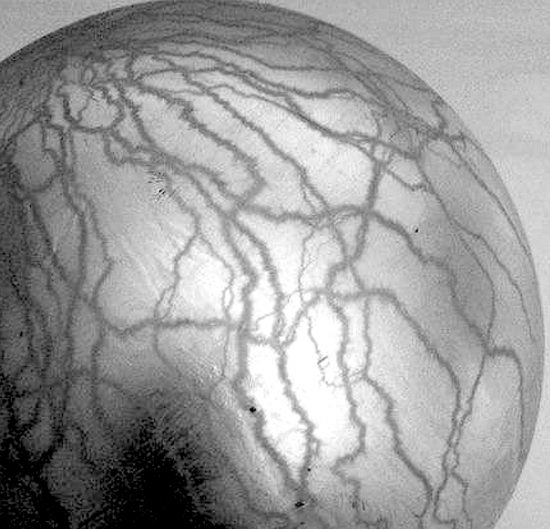
An aluminized rubber ball after exposure to an electric arc for approximately one second. Credit: Cj Ransom
Sep 28, 2016
Europa is not a harbor for life.
In March of 1979 Voyager 1 found that Europa appeared to be completely encased in water ice, with few craters. Sinuous channels, called “rilles,” extend for thousands of kilometers across its face. Cycloid, dual ridge “faults” mystified NASA mission team members and continue to do so.
Based on recent observations by the Hubble Space Telescope, astrophysicists speculate that there are lakes of water beneath Europa’s ice, just above a salty ocean. Computer simulations indicate that Europa has a thick shell of water ice floating on top of the conjectural sea. Mainstream theories state that the moon is “kneaded” by gravitational tides from Jupiter, creating stress cracks that form gigantic ice rafts. Like icebergs on Earth, the rafts are said to float, merging and separating due to heat from the moon’s interior. That heat is also conventionally attributed to Jupiter’s gravitational forces.
Do breaking and colliding ice rafts create parallel grooves with levees several meters high? Europa’s rilles are not analogous to ice cracks on Earth, since variations in thickness and composition that repeat over long distances should not be expected. Yet, repetitive patterns are observed on Europa. The swirls and loops that cover the moon are only duplicated in the laboratory using plasma discharge equipment.
According to a previous Picture of the Day, planetary scientists, using the Hubble Space telescope, believed that they detected plumes of water vapor escaping from Europa’s south polar region. Later observations found no sign of the “geyser” activity.
Geoff Yoder, acting associate administrator for NASA’s Science Mission Directorate wrote:
“Europa’s ocean is considered to be one of the most promising places that could potentially harbor life in the solar system. These plumes, if they do indeed exist, may provide another way to sample Europa’s subsurface.”
When the Galileo space probe explored Jupiter and its moons, it detected electrical activity between them. So-called “volcanic” plumes were seen erupting from Io. As other Picture of the Day articles argue, the plumes are the result of cathode arcs, electrically etching the surface and blasting sulfur dioxide “snow” up to 150 kilometers into space. Those electric discharges are now acknowledged because the “footprints” of all four of Jupiter’s large moons were seen in its aurora.
Consensus viewpoints misinterpret rilles on Europa as “vents,” channeling water to the surface. Based on Electric Universe theory, they are incisions on the moon caused by traveling electric arcs. Europa was once gouged and torn, rather than cracked and broken. A giant electric auger cut across the surface, disregarding the topography: a sure sign that electricity was the active agent. Europa’s rilles show parallelism, not because they are open cracks, but because filaments of electric charge traveling across a surface tend to align and follow the ambient magnetic field direction.
Electric Universe advocates propose that the rilles and hot pole on Europa are heated by electromagnetic induction, where an electric current returns to Jupiter’s plasma sheath. As electrical input to Europa varies, the strength of the ultraviolet signal also varies, creating a false impression of water vapor plumes that come and go.
Stephen Smith












